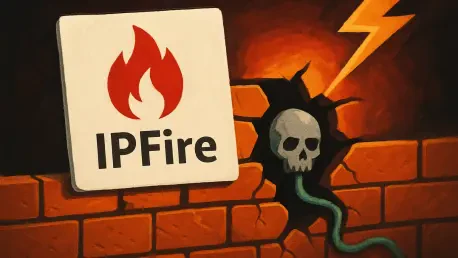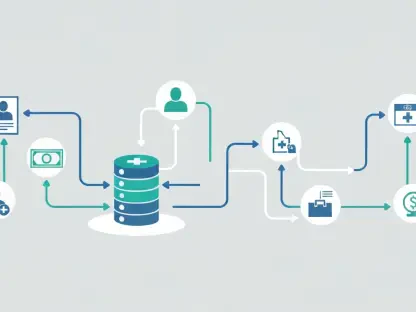In an era where cybersecurity threats loom larger than ever, a newly discovered flaw in a popular open-source firewall solution has sent shockwaves through the IT community, raising urgent concerns about the safety of network infrastructures worldwide. IPFire, trusted by countless organizations for perimeter defense, has been found to harbor a severe vulnerability in its web-based administrative interface. Identified as CVE-2025-50975, this flaw in version 2.29 allows for stored cross-site scripting (XSS) attacks, potentially compromising the entire system through malicious JavaScript injection. The implications are dire, as attackers with administrative access can exploit this weakness to hijack sessions or manipulate firewall rules, putting internal networks at significant risk. This revelation underscores the critical need for robust security measures even in trusted tools, prompting a deeper look into the nature of the vulnerability, its potential impact, and the immediate steps required to safeguard affected systems.
Understanding the Security Flaw
Nature of the Stored XSS Threat
The vulnerability at the heart of IPFire 2.29 lies in the firewall rule editor within the web interface, specifically in the firewall.cgi component. This stored XSS flaw emerges from inadequate input sanitization in several key parameters, enabling authenticated administrators to embed malicious scripts into the system. Once injected, these scripts persist and execute automatically whenever another administrator accesses the rules page, creating a seamless pathway for exploitation. The simplicity of this attack vector is alarming, as it requires no advanced deception beyond valid admin credentials. This means that environments with multiple administrators are particularly vulnerable, as trust in shared access becomes a potential liability. The flaw’s persistent nature ensures that the malicious code remains a threat until manually detected or mitigated, amplifying the urgency for organizations to address this issue before it can be exploited by rogue insiders or compromised accounts.
Technical Breakdown and Attack Simplicity
Delving deeper into the technical aspects, the lack of proper validation in specific input fields within the firewall rule editor is the root cause of this vulnerability. Attackers can craft payloads that, once saved, become embedded in the system’s configuration, lying in wait for unsuspecting administrators to trigger them. The low complexity of this exploit is a critical concern, as it does not require sophisticated tactics or external tools beyond standard access privileges. Proof-of-concept demonstrations have shown how easily a malicious script can be inserted during rule creation, only to execute when another user views the same page. This seamless execution compromises both the confidentiality and integrity of the system, potentially allowing attackers to steal session cookies or perform unauthorized actions. For organizations relying on IPFire for network security, this flaw represents a significant breach in the expected protection, necessitating immediate attention to prevent unauthorized access to sensitive configurations.
Implications and Mitigation Strategies
Potential Impact on Network Security
The consequences of exploiting this vulnerability in IPFire 2.29 are far-reaching and deeply concerning for any organization using this firewall solution. A successful attack can lead to session hijacking, where attackers gain control over an administrator’s active session, enabling them to alter firewall rules or access restricted areas of the system. Beyond individual breaches, the compromised interface can serve as a pivot point to target internal networks, exposing sensitive data and critical infrastructure to further attacks. The ripple effect of such a breach could undermine trust in the entire security framework, especially in environments where multiple administrators share access. This vulnerability highlights a broader issue in administrative tools: the inherent trust placed in high-privilege users can become a weak link if not safeguarded by stringent controls. The potential for widespread damage makes it imperative for affected entities to act swiftly in addressing this critical security gap.
Actionable Steps for Administrators
Addressing this severe flaw requires a multi-faceted approach to secure affected systems and prevent future exploits. Administrators are urged to update IPFire to a patched version beyond 2.29, which incorporates enhanced input sanitization to block malicious scripts. Restricting GUI access to a minimal number of trusted users has become a key recommendation, significantly reducing the attack surface. Implementing multi-factor authentication has emerged as another vital step, adding an extra layer of defense against credential compromise. Additionally, enforcing a strict Content Security Policy (CSP) header is advised to limit the execution of inline scripts, thereby curbing the impact of XSS attacks. Regular audits of firewall rules for suspicious content or unexpected script tags are also suggested as a proactive measure to detect any signs of exploitation. These combined efforts aim to fortify systems against the persistent threat posed by this vulnerability, ensuring that network defenses remain robust in the face of evolving risks.
Looking Ahead to Stronger Defenses
Reflecting on the response to this issue, it has become evident that ongoing vigilance is essential for maintaining security in open-source tools like IPFire. Beyond immediate patches, organizations are encouraged to adopt a mindset of continuous monitoring and improvement, integrating regular security assessments into their operational routines. Exploring advanced threat detection mechanisms and investing in administrator training to recognize potential exploits are seen as critical next steps. The broader community is prompted to contribute to enhancing input validation frameworks, ensuring that similar flaws will be less likely in future iterations. As cyber threats continue to evolve, fostering collaboration between developers and end-users stands out as a cornerstone for building more resilient systems. This incident serves as a stark reminder of the importance of proactive security measures, paving the way for stronger, more adaptive defenses in the ever-changing landscape of network protection.









